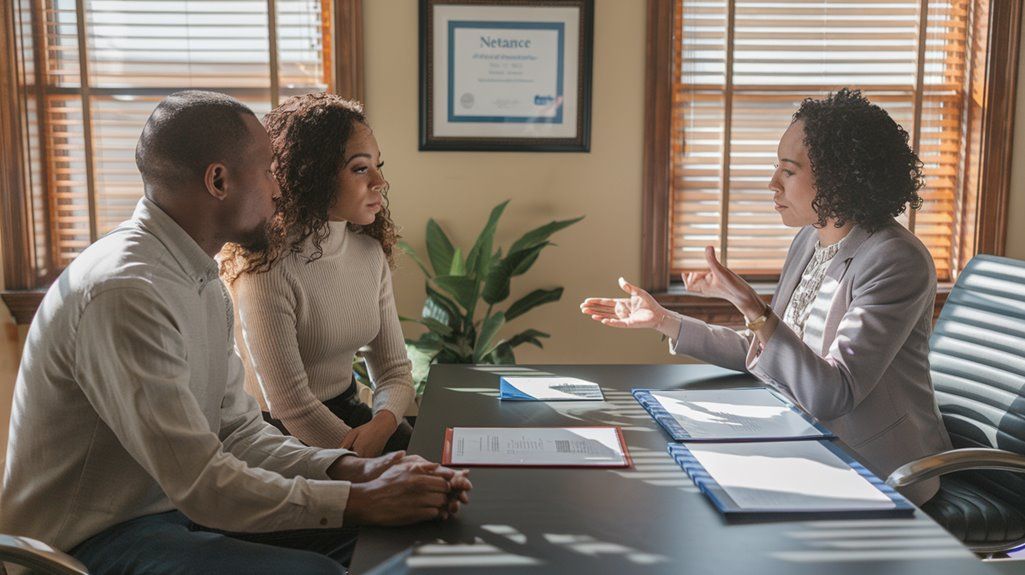What Sets Child Counseling Apart From Adult Therapy in Terms of Techniques and Approaches?
Share this article:

Child counseling and adult therapy differ because they're made for minds at different stages. Kids are still figuring out their feelings and thoughts, so counselors use play, art, and games to help them express what's hard to put into words. It's not just talking; it's doing activities that let them show and understand their emotions. Parents and schools often play a big part too, providing extra support. Adults, on the other hand, might dive deeper into conversations about their life and choices. Childhood challenges are unique, and these tailored approaches ensure kids get the right kind of help. Stick with us, and you'll uncover even more insights into how this special support works.
Key Takeaways
- Child counseling often utilizes play-based interventions, allowing kids to express emotions and experiences creatively.
- Parental involvement is emphasized in child therapy to enhance communication skills and support behavioral goals.
- Collaboration with schools is key in child therapy to create a comprehensive support system around the child.
- Techniques in child counseling are adapted for age-appropriate communication to meet children's emotional and cognitive levels.
- Child-specific issues, such as bullying or parental divorce, require tailored approaches not typically found in adult therapy.
Developmental Perspective
Understanding the unique ways kids and adults grow and change is crucial when comparing child counseling and adult therapy techniques. You see, as you're eager to serve others, grasping the developmental perspective is key. It's about acknowledging that kids aren't just small adults; their worlds are vastly different. They're in the thick of developing their emotional, cognitive, and social selves. Their problems might seem small to an adult, but to them, they're as big as the world.
Adults, on the other hand, have a more established sense of self. Their issues often stem from deeper, more complex roots such as long-standing patterns, relationships, or life transitions. They've got a lifetime of experiences shaping their views, making their therapy needs distinct from children's.
In your quest to serve effectively, understanding this developmental dichotomy allows you to tailor your approach. You'll learn to meet kids where they are, using language and concepts they grasp, while offering adults the depth and reflection their experiences demand. It's about being as adaptable as the people you're aiming to help, bridging the gap between knowing and understanding. This perspective is your foundation, ensuring you're not just heard, but truly understood.
Play-Based Interventions
You've probably noticed how naturally kids turn to play as a way to express themselves.
In child counseling, this instinct is harnessed through play-based interventions, which offer unique benefits and employ specific techniques.
Let's explore how these approaches can unlock feelings and facilitate healing in ways that words sometimes cannot.
Therapeutic Play Benefits
Exploring the world of therapeutic play unlocks a treasure trove of benefits, offering children a unique way to process their emotions and experiences. Through play, kids can express themselves in a language they're fluent in, beyond words. It's a safe space where they can explore feelings, confront fears, and practice problem-solving skills without the pressure of getting it right on the first try.
They learn resilience and develop social skills by navigating the rules of play, turn-taking, and empathy. For you, aiming to support and guide, understanding the power of play is crucial. It's not just play; it's their way of making sense of the world, mastering challenges, and communicating needs.
Techniques in Play Therapy
Having grasped the significance of therapeutic play, let's now examine the specific techniques in play therapy that can make a profound difference in a child's healing journey. You'll find that using storytelling and role-play allows kids to express their feelings and experiences in a safe, imaginative way. It's like unlocking their emotional world through the characters they create or the scenarios they enact.
Sandtray therapy offers another avenue, where children arrange figures in a sandbox to represent their inner thoughts and relationships. This technique doesn't rely on verbal communication, making it perfect for those who find words hard to come by.
Lastly, creative arts involve drawing, painting, or sculpting, providing a visual form of expression. These activities not only help in articulating feelings but also in building a sense of control and self-esteem. Through these techniques, children learn to communicate, solve problems, and heal in a way that's natural and enjoyable for them.
Parental Involvement
You're stepping into a crucial part of child counseling: parental involvement.
This is where you learn to strengthen your communication with your child and set clear, achievable behavioral goals.
It's a journey that empowers both you and your child, paving the way for positive changes.
Enhancing Communication Skills
As a parent, you'll find that actively involving yourself in your child's therapy can significantly boost their progress in developing better communication skills. Engaging in the therapy process not only shows your child that they're not alone but also teaches you techniques to help them express themselves more effectively. Here's how you can help:
- Model positive communication at home.
- Encourage them to share their feelings daily.
- Listen actively, showing that their thoughts and feelings matter.
- Provide feedback that's constructive and supportive.
- Celebrate small victories together, reinforcing their progress.
Your involvement creates a nurturing environment for your child to practice and enhance their communication skills. It's about being their cheerleader, guide, and most importantly, their safe space to fall back on.
Setting Behavioral Goals
Beyond enhancing communication skills, it's equally important to work with your child on setting behavioral goals to guide their development further.
Imagine you're creating a roadmap together, where each goal is a milestone they'll feel proud reaching. It's not just about correcting behavior; it's about empowering your child to recognize their strengths and how they can use them to overcome challenges.
This approach fosters a sense of ownership and responsibility in your child. Remember, your role isn't to dictate these goals but to facilitate a conversation that helps your child identify what they want to achieve.
Through this collaborative effort, you're not just setting them up for immediate successes; you're instilling skills that will serve them well throughout life.
School Collaboration
When it comes to navigating your child's mental health, collaborating closely with their school can significantly enhance the support they receive. Understanding that you're not alone in this journey can be a huge relief. Schools often have resources and professionals that are specifically trained to support children's well-being and can provide a supportive environment that complements the therapy process.
Imagine this collaboration bringing to life:
- Tailored Support Plans: Teachers and counselors working together to create an environment that meets your child's unique needs.
- Regular Updates: Frequent communication between you and the school, ensuring you're informed and involved in your child's progress.
- Intervention Strategies: Sharing effective strategies and tools that can be used both at home and in school settings.
- Awareness and Education: Schools can offer workshops or sessions for parents, providing valuable insights into supporting children's mental health.
- Community Building: Connecting with other parents facing similar challenges, creating a supportive community around your child.
Age-Appropriate Communication
Understanding your child's world through their eyes is crucial, and that's where age-appropriate communication becomes a key player in supporting their mental health journey. When you're trying to connect with a child, it's essential to meet them where they are, not where you expect them to be. This means tailoring your language, tone, and even your body language to match their level of understanding and emotional maturity.
You've got to remember that children process information and emotions differently than adults. They mightn't have the vocabulary to express what they're feeling or understand complex concepts. That's why it's vital to simplify your language without talking down to them. Ask open-ended questions that encourage them to express themselves, and listen— really listen —to their responses.
It's also about being patient and giving them the time they need to respond. Sometimes, they might need a moment to think about their feelings or how to word their thoughts. Showing you're willing to wait can make a big difference in making them feel heard and valued.
Creative Expression
Creative expression offers a powerful outlet for children to explore and communicate their feelings in a way that words sometimes can't capture. As someone keen on serving others, especially the younger ones, understanding the value of creative avenues in therapy is crucial. Children often find it easier to express themselves through activities that don't require them to directly articulate their thoughts and emotions. This method not only facilitates deeper understanding but also fosters a safe environment for emotional exploration.
Imagine a child's journey through counseling enriched with:
- Drawing and Painting: A canvas becomes a silent witness to a child's inner world, revealing fears, dreams, and everything in between.
- Play Therapy: Toys and games serve as tools for expression, allowing children to play out their feelings and experiences in a controlled setting.
- Music and Movement: Rhythms and melodies offer a non-verbal language for emotions, while dance allows those feelings to flow through physical movement.
- Storytelling and Role-Play: Creating and acting out stories help children explore different perspectives and process their own narratives.
- Crafting: The tactile experience of making something tangible can be a profound way for children to externalize complicated feelings.
These creative modalities offer invaluable pathways for children to express themselves, making your role in facilitating this process both a privilege and a profound responsibility.
Child-Specific Issues
While addressing the needs of young ones in therapy, it's crucial to recognize that children face issues unique to their stage of life and development. These aren't just scaled-down versions of adult problems; they're challenges that stem from their growing minds and bodies, as well as their limited experiences in the world.
For instance, children might struggle with expressing their emotions or understanding complex situations. They could be dealing with bullying, difficulties in making friends, or coping with their parents' divorce. These situations can significantly impact their emotional well-being, but they mightn't have the words to express how they're feeling.
It's also important to remember that children's brains are still developing. This means they mightn't process information or react to situations in the same way adults do. Their understanding of cause and effect is different, and they may have irrational fears or develop habits as coping mechanisms.
As someone looking to serve and support these young individuals, it's essential to approach them with patience, understanding, and strategies tailored to their unique needs. Recognizing the specific issues children face is the first step in providing them with the support they need to flourish.
Confidentiality Boundaries
When discussing therapy for children or adults, it's crucial to realize that confidentiality isn't just a professional obligation; it's a cornerstone of trust. For those of you passionate about serving, understanding the nuances of confidentiality in child counseling is essential. It's a delicate balance, requiring a keen awareness of the child's needs, the parents' concerns, and legal mandates.
In child therapy, confidentiality boundaries shape the therapeutic environment, creating a safe space for young clients to open up. To visualize this, consider:
- A secure room , where a child feels safe to share their deepest fears without judgment.
- A locked diary , symbolizing the therapist's commitment to keeping the child's disclosures private.
- A bridge , representing the careful negotiation of information sharing between therapist, child, and parents.
- A safety net , illustrating the protection confidentiality offers to a vulnerable child.
- A garden fence , demarcating the boundaries of private information that shouldn't be crossed without permission.
Navigating these boundaries with sensitivity ensures that the therapeutic relationship remains a sanctuary for healing. Remember, in child counseling, your ability to maintain confidentiality while engaging parents constructively is key to fostering trust and facilitating meaningful progress.
Legal Considerations
Understanding the legal aspects of confidentiality in therapy can feel overwhelming, but it's crucial for protecting both you and your clients. When it comes to child counseling, you're navigating not just the waters of mental health, but also a sea of legal requirements that can seem daunting at first.
Remember, you're not just a counselor; you're a guardian of your client's trust and a bridge to their well-being. This means understanding the limits of confidentiality, especially when it involves potential harm to the child or others. You're required to report any such risks, which is a delicate balance between legal obligation and therapeutic trust.
Moreover, gaining consent for therapy with minors involves parents or guardians, which adds another layer to the legal landscape you navigate. It's your job to clarify who's the right to access the child's therapy records and under what circumstances.
Engage parents or guardians in this process with empathy and clarity, ensuring they understand their role, rights, and the boundaries of confidentiality. This builds a partnership that not only meets legal standards but also fosters a supportive environment for the child's healing journey.
In a nutshell, while the legal considerations in child counseling can seem complex, they're fundamental in creating a safe space for healing and growth. Your role is pivotal in weaving together legal diligence with compassionate care.
Frequently Asked Questions
How Does the Cost of Child Counseling Compare to Adult Therapy, and Are There Financial Assistance Programs Available for Families?
Child counseling often costs similarly to adult therapy, but you'll find financial assistance programs available. These can ease the burden, ensuring kids get the help they need without straining the family's budget.
Can Child Counseling Techniques Be Effectively Adapted for Use in Online or Telehealth Settings, Especially in Remote or Underserved Areas?
Ironically, you'd think technology would widen gaps, yet it's making child counseling more accessible. Techniques can be adapted for online use, offering hope and support to kids in remote areas who'd otherwise be isolated.
How Do Cultural and Linguistic Factors Influence the Choice of Counseling Techniques and Approaches for Children From Diverse Backgrounds?
You must consider a child's cultural and linguistic background when choosing counseling methods. It ensures they feel understood and supported, making therapy more effective and building trust in a respectful, empathetic way.
What Role Does Nutrition and Physical Health Play in the Effectiveness of Child Counseling Sessions Compared to Adult Therapy?
In child counseling, nutrition and physical health play a crucial role, more so than in adult therapy. They're key to a child's emotional and cognitive development, impacting how effective counseling sessions can be for them.
How Do Advancements in Neuroscience and Understanding of Brain Development Impact the Evolution of Child Counseling Methods Over Time?
Like a garden thriving with the right care, advancements in neuroscience help child counseling evolve, ensuring techniques are tailored for young brains, making therapy more effective and engaging for the kids you're eager to support.
Connect with Us:
Connect with Us:



